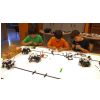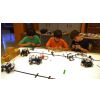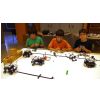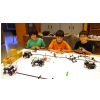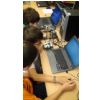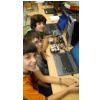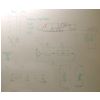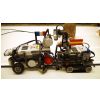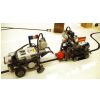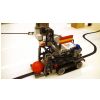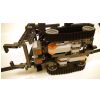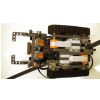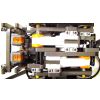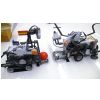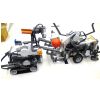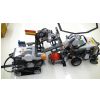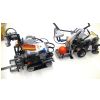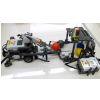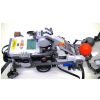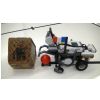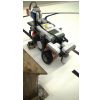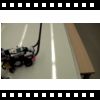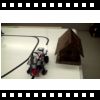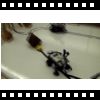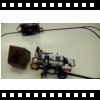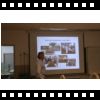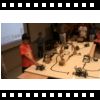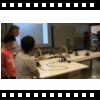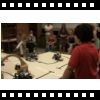Second Educational Robotics International Summer Course by BOGATECH and LMFL at Ordino, Andorra
15 to 29-08-12
For the second time, BOGATECH Educational Robotics Workshop and Language and Music For Life (LMFL) organized in collaboration the Educational Robotics International Summer Course at Ordino, Andorra. The intensive course is organized in daily sessions of three hours. The course is taught in English and is a very good language practice for the international students. For native English students, the course can also be taught in three other different languages (French, Spanish and Catalan). The course is structured in two different parts, the first week it covers a full program that allows students to get the knowledge and experience to build and program autonomous robots, and the second week the students develop a common project that offers them an opportunity to put together the knowledge acquired and to work in teams.
This time, the subject of the educational robotics project was inspired on the Second World War, due to the material of the workshop classroom where we did the course. In addition, thanks to the LEGO Technic construction knowledge of one course student, the students decided to build a tank with a quite sophisticated power system, capable of climbing steep ramps.
Giving students real subjects to use as metaphors to build their projects connects them to the real world, helps them to frame their work with real research studies and it is extremely encouraging and exciting. It is also an opportunity to realize that understanding science or any subject can be done at different levels and by anyone with enough desire and perseverance.
The students built four different types of robots with different levels of difficulty. The first robot was the simplest moving robot which had to take a victim from the battle field (represented by a ball) and deliver it to the tank to cross the battle field. This robot used a light sensor to follow a line and two ultrasonic sensors, one to follow a wall when there is no line and another one to detect the tank. The second robot, the tank, was the most complex robot in terms of construction. It had two asymmetrically oriented motors to minimize its width and used two light sensors to follow the line and detect intersections, and an ultrasonic sensor to detect the ball when delivered by the first robot. The tank had to deliver the victim to a third robot, an ambulance, raising its special arm to drop it into the ambulance container. The ambulance, which had to bring the victim to the hospital robot, was provided with two line sensors like the tank and an ultrasonic sensor to detect the victim when delivered by the tank. Finally, the hospital was a simple static robot that used an ultrasonic sensor to detect an incoming victim delivered by the mobile container of the ambulance, and was capable of turning on its lights and ventilation system.
In the final public presentation, the students explained the audience how to program a simple robot, the challenge, the construction and computer programs of the robots, and at the end, they made a live demo of the challenge. This final exercise is designed to put together all the concepts learnt during the course and it is about learning, more than solving successfully the exercise, and developing the ability and skills to explain the individual work and team work as well as the technical and strategic issues involved in the project.
Per segona vegada, el Taller de Rob˛tica Educativa BOGATECH i Language and Music For Life (LMFL) van organitzar en colĚlaboraciˇ el Curs Internacional d'Estiu de Rob˛tica Educativa a Ordino, Andorra. El curs intensiu s'organitza amb sessions diÓries de tres hores. El curs es fa en anglŔs i Ús una molt bona forma de practicar la llengua pels alumnes internacionals. Pels alumnes anglesos natius, el curs es pot impartir en tres altres llengŘes (francŔs, castellÓ i catalÓ). El curs s'estructura en dues parts diferents, la primera setmana cobreix un programa complert que permet als alumnes adquirir el coneixement i experiŔncia per construir i programar robots aut˛noms, i la segona setmana els alumnes desenvolupen un projecte com˙ que els hi ofereix l'oportunitat d'ajuntar els coneixements adquirits i de treballar en equip.
Aquesta vegada, el tema del projecte de rob˛tica educativa es va inspirar en la Segona Guerra Mundial, degut al material de l'aula taller on vÓrem fer el curs. A mÚs, grÓcies al coneixement de construcciˇ amb LEGO Technic d'un alumne del curs, els estudiants vÓrem decidir construir un tanc amb un sistema de propulsiˇ bastant sofisticat, capaš de pujar rampes inclinades.
Utilitzar temes reals per utilitzar com a metÓfores per construir els seus projectes connecta els estudiants amb el mˇn real, els ajuda a encaixar el seu treball amb els estudis de recerca reals i Ús extremadament motivador i excitant. TambÚ suposa una oportunitat per adonar-se que entendre la ciŔncia o qualsevol altre tema es pot fer a diferents nivells y per qualsevol persona amb suficient desig i perseveranša.
Els alumnes van construir quatre tipus de robots diferents amb nivells de dificultat diferents. El primer robot va ser el robot m˛bil mÚs senzill, i tenia que agafar una vÝctima del camp de batalla (representada per una pilota) i entregar-la a un tanc per travessar el camp de batalla. Aquest robot utilitzava un sensor de llum per seguir la lÝnia i dos sensor ultras˛nics, un per seguir una paret quan no hi ha lÝnia i un altre per detectar el tanc. El segon robot, el tanc, va ser el robot mÚs complex en termes de construcciˇ. Comptava amb dos motors asimŔtricament orientats per minimitzar la seva amplada i utilitzava dos sensors de llum per seguir la lÝnia i detectar interseccions, i un sensor ultras˛nic per detectar la pilota al ser lliurada pel primer robot. El tanc tenia que entregar la vÝctima al tercer robot, una ambulÓncia, aixecant el seu braš especial per deixar-la caure dins el contenidor de l'ambulÓncia. L'ambulÓncia, que tenia que portar la vÝctima al robot hospital, comptava amb dos sensors de llum com el tanc i un sensor ultras˛nic per detectar la vÝctima al ser lliurada pel tanc. Finalment, l'hospital era un robot estÓtic simple que utilitzava un sensor ultras˛nic per detectar una vÝctima entrant lliurada pel contenidor m˛bil de l'ambulÓncia, i era capaš d'encendre les seves llums i sistema de ventilaciˇ.
En la presentaciˇ p˙blica, els alumnes varen explicar a l'audiŔncia cˇm programar un robot simple, el repte, la construcciˇ i programaciˇ dels robots, i al final, varen fer una demostraciˇ en directe del repte. Aquest exercici final estÓ dissenyat per ajuntar tots els conceptes apresos durant el curs on es tracta d'aprendre, mÚs que de solucionar exitosament l'exercici, i de desenvolupar l'habilitat i aptituds per explicar el treball individual i en equip aixÝ com els temes tŔcnics i estratŔgics continguts en el projecte.
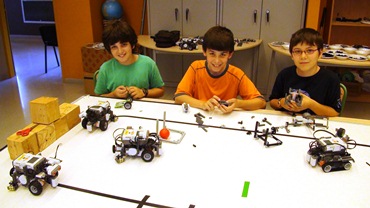
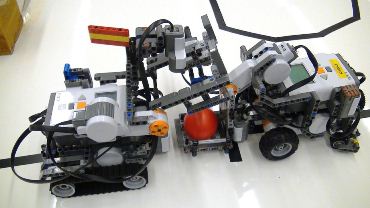
This time, the subject of the educational robotics project was inspired on the Second World War, due to the material of the workshop classroom where we did the course. In addition, thanks to the LEGO Technic construction knowledge of one course student, the students decided to build a tank with a quite sophisticated power system, capable of climbing steep ramps.
Giving students real subjects to use as metaphors to build their projects connects them to the real world, helps them to frame their work with real research studies and it is extremely encouraging and exciting. It is also an opportunity to realize that understanding science or any subject can be done at different levels and by anyone with enough desire and perseverance.
The students built four different types of robots with different levels of difficulty. The first robot was the simplest moving robot which had to take a victim from the battle field (represented by a ball) and deliver it to the tank to cross the battle field. This robot used a light sensor to follow a line and two ultrasonic sensors, one to follow a wall when there is no line and another one to detect the tank. The second robot, the tank, was the most complex robot in terms of construction. It had two asymmetrically oriented motors to minimize its width and used two light sensors to follow the line and detect intersections, and an ultrasonic sensor to detect the ball when delivered by the first robot. The tank had to deliver the victim to a third robot, an ambulance, raising its special arm to drop it into the ambulance container. The ambulance, which had to bring the victim to the hospital robot, was provided with two line sensors like the tank and an ultrasonic sensor to detect the victim when delivered by the tank. Finally, the hospital was a simple static robot that used an ultrasonic sensor to detect an incoming victim delivered by the mobile container of the ambulance, and was capable of turning on its lights and ventilation system.
In the final public presentation, the students explained the audience how to program a simple robot, the challenge, the construction and computer programs of the robots, and at the end, they made a live demo of the challenge. This final exercise is designed to put together all the concepts learnt during the course and it is about learning, more than solving successfully the exercise, and developing the ability and skills to explain the individual work and team work as well as the technical and strategic issues involved in the project.
Per segona vegada, el Taller de Rob˛tica Educativa BOGATECH i Language and Music For Life (LMFL) van organitzar en colĚlaboraciˇ el Curs Internacional d'Estiu de Rob˛tica Educativa a Ordino, Andorra. El curs intensiu s'organitza amb sessions diÓries de tres hores. El curs es fa en anglŔs i Ús una molt bona forma de practicar la llengua pels alumnes internacionals. Pels alumnes anglesos natius, el curs es pot impartir en tres altres llengŘes (francŔs, castellÓ i catalÓ). El curs s'estructura en dues parts diferents, la primera setmana cobreix un programa complert que permet als alumnes adquirir el coneixement i experiŔncia per construir i programar robots aut˛noms, i la segona setmana els alumnes desenvolupen un projecte com˙ que els hi ofereix l'oportunitat d'ajuntar els coneixements adquirits i de treballar en equip.
Aquesta vegada, el tema del projecte de rob˛tica educativa es va inspirar en la Segona Guerra Mundial, degut al material de l'aula taller on vÓrem fer el curs. A mÚs, grÓcies al coneixement de construcciˇ amb LEGO Technic d'un alumne del curs, els estudiants vÓrem decidir construir un tanc amb un sistema de propulsiˇ bastant sofisticat, capaš de pujar rampes inclinades.
Utilitzar temes reals per utilitzar com a metÓfores per construir els seus projectes connecta els estudiants amb el mˇn real, els ajuda a encaixar el seu treball amb els estudis de recerca reals i Ús extremadament motivador i excitant. TambÚ suposa una oportunitat per adonar-se que entendre la ciŔncia o qualsevol altre tema es pot fer a diferents nivells y per qualsevol persona amb suficient desig i perseveranša.
Els alumnes van construir quatre tipus de robots diferents amb nivells de dificultat diferents. El primer robot va ser el robot m˛bil mÚs senzill, i tenia que agafar una vÝctima del camp de batalla (representada per una pilota) i entregar-la a un tanc per travessar el camp de batalla. Aquest robot utilitzava un sensor de llum per seguir la lÝnia i dos sensor ultras˛nics, un per seguir una paret quan no hi ha lÝnia i un altre per detectar el tanc. El segon robot, el tanc, va ser el robot mÚs complex en termes de construcciˇ. Comptava amb dos motors asimŔtricament orientats per minimitzar la seva amplada i utilitzava dos sensors de llum per seguir la lÝnia i detectar interseccions, i un sensor ultras˛nic per detectar la pilota al ser lliurada pel primer robot. El tanc tenia que entregar la vÝctima al tercer robot, una ambulÓncia, aixecant el seu braš especial per deixar-la caure dins el contenidor de l'ambulÓncia. L'ambulÓncia, que tenia que portar la vÝctima al robot hospital, comptava amb dos sensors de llum com el tanc i un sensor ultras˛nic per detectar la vÝctima al ser lliurada pel tanc. Finalment, l'hospital era un robot estÓtic simple que utilitzava un sensor ultras˛nic per detectar una vÝctima entrant lliurada pel contenidor m˛bil de l'ambulÓncia, i era capaš d'encendre les seves llums i sistema de ventilaciˇ.
En la presentaciˇ p˙blica, els alumnes varen explicar a l'audiŔncia cˇm programar un robot simple, el repte, la construcciˇ i programaciˇ dels robots, i al final, varen fer una demostraciˇ en directe del repte. Aquest exercici final estÓ dissenyat per ajuntar tots els conceptes apresos durant el curs on es tracta d'aprendre, mÚs que de solucionar exitosament l'exercici, i de desenvolupar l'habilitat i aptituds per explicar el treball individual i en equip aixÝ com els temes tŔcnics i estratŔgics continguts en el projecte.


